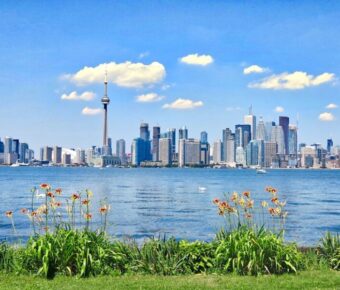
Corfu vs Lefkada: Which Greek Island Paradise Offers the Best Beach Experience in 2025
Planning a Greek island getaway can feel overwhelming with so many beautiful options to choose from. The Ionian Islands of Corfu and Lefkada each offer something special for travelers seeking their slice of Mediterranean paradise.
Corfu suits travelers wanting a larger island with diverse attractions and rich history, while Lefkada is perfect for beach lovers seeking a more laid-back family atmosphere. Both islands share the stunning blue waters of the Ionian Sea, but their personalities couldn’t be more different.
Corfu charms visitors with its mix of cultures, from Venetian architecture to British influences, spread across its green mountainous landscape. Lefkada keeps things simple with its easy mainland access and world-class beaches like Porto Katsiki. These two gems of western Greece provide unique island experiences that cater to different types of travelers.
Table of Contents
- Geography and Access
- Location in the Ionian Sea
- Access to Corfu and Lefkada
- Historical Significance
- Corfu’s Venetian Past
- Lefkada and the Myths of Odysseus
- Natural Attractions
- Corfu’s Lush Landscapes
- Lefkada’s Rugged Mountains
- Beaches and Coastal Exploration
- Beach Highlights in Corfu
- Lefkada’s Renowned Beaches
- Culinary Experiences
- Local Gastronomy of Corfu
- Lefkada’s Tavernas and Restaurants
- Village Charm and Culture
- Picturesque Villages in Corfu
- Exploring Lefkada’s Villages
- Activities and Experiences
- Outdoor Adventures on Corfu
- Lefkada’s Adventure Sports
- Best Time to Visit
- Corfu’s Seasonal Attractions
- Lefkada’s Peak and Off-Peak Seasons
- Frequently Asked Questions
- What are the main differences in attractions between Corfu and Lefkada?
- Can you recommend which island is better for families, Corfu or Lefkada?
- What distinguishes Corfu’s nightlife compared to that of Lefkada?
- How do the beaches of Lefkada measure up against those in Corfu?
- Which island offers more cultural and historical experiences, Corfu or Lefkada?
- In terms of natural scenery, do Corfu or Lefkada offer more unique landscapes?
- Book Your Dream Experience
- More Travel Guides
Geography and Access
Both islands sit in the stunning Ionian Sea, but their locations create different experiences for travelers. Corfu connects easily to mainland Europe, while Lefkada links directly to mainland Greece.
Location in the Ionian Sea
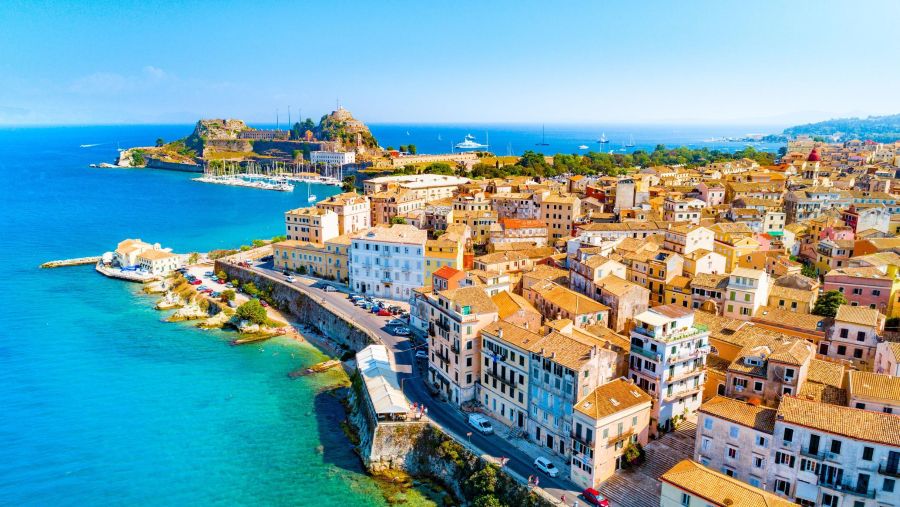
Corfu floats in the northern Ionian Sea, right off Albania’s coast. It’s the second-largest Ionian island at 592 square kilometers. The island’s position makes it a natural gateway between Greece and Italy.
Lefkada sits further south, near Kefalonia and Ithaca. It’s smaller than Corfu at 336 square kilometers. Unlike other Greek islands, Lefkada connects to mainland Greece by a floating bridge and causeway.
Access to Corfu and Lefkada
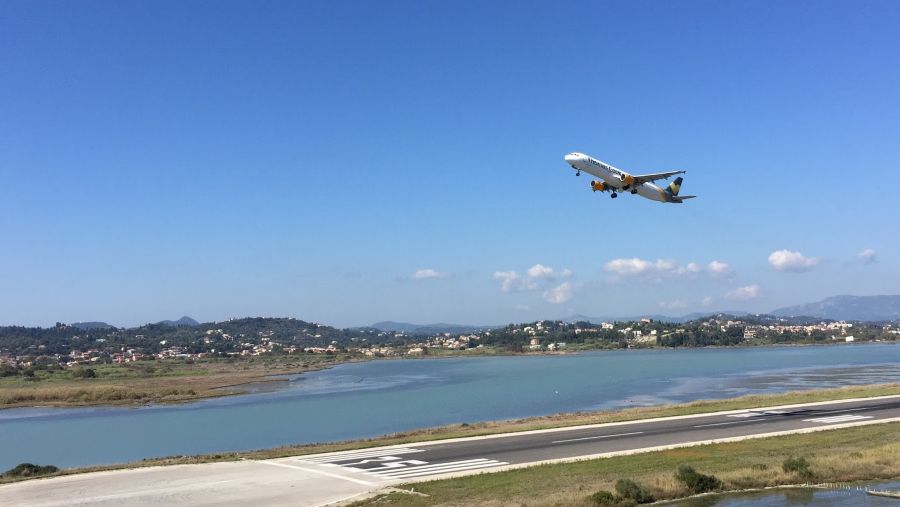
Corfu welcomes visitors through its international airport, which handles direct flights from many European cities. The island also receives ferries from Italy, Albania, and mainland Greece.
Getting to Lefkada takes a different path. Since it connects to the mainland by road, you can drive straight onto the island. The closest airport is Aktion/Preveza, about 20 minutes away by car.
Ferry services run from Lefkada’s east coast to nearby islands like Kefalonia and Ithaca. The island’s road connection makes it popular with Greek tourists who can drive from Athens in about 4-5 hours.
Corfu offers more transport options for international travelers. Lefkada’s mainland connection makes it easier to explore multiple Greek destinations by car.
Historical Significance
Both islands hold deep historical roots stretching back thousands of years, with stories of ancient civilizations, mythological tales, and cultural treasures that shape their identities today.
Corfu’s Venetian Past
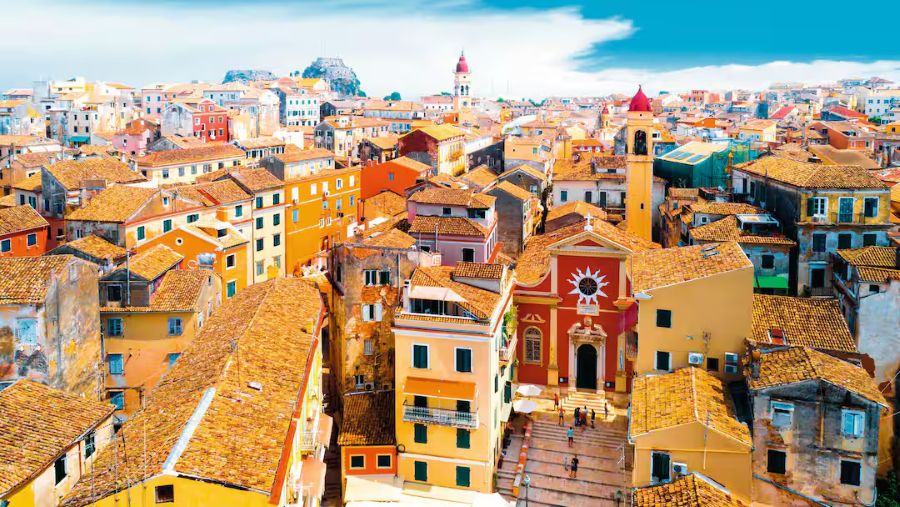
The Venetians left an unmistakable mark on Corfu during their 400-year rule. The Old Town stands as a UNESCO World Heritage site, packed with stunning architecture from this era.
The two massive fortresses – the Old Fortress and New Fortress – protected the island from Ottoman invasions. These strongholds remain some of the most impressive military structures in the Mediterranean.
Wandering through Corfu Town feels like stepping into an Italian city. The Liston arcade, inspired by Paris’s Rue de Rivoli, features elegant arched walkways where locals still gather for coffee.
Lefkada and the Myths of Odysseus
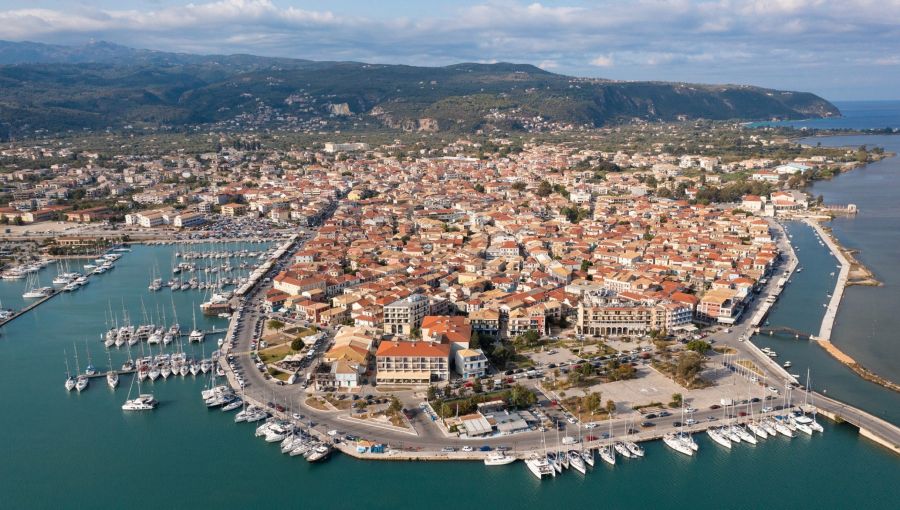
Many scholars believe Lefkada was Homer’s ancient Ithaca, the homeland of Odysseus. The island’s rugged landscape matches descriptions from The Odyssey.
The Santa Lefkada Castle, built in the 14th century, guards the entrance to the island. This impressive fortress tells tales of pirates, invasions, and changing empires through the ages.
Ancient artifacts found near modern Kalligoni point to Nirikos, the island’s ancient capital from the 7th century BC. These ruins offer glimpses into daily life from thousands of years ago.
The Faneromeni Monastery stands as one of Greece’s most important religious sites, with its iconic bell tower visible across the island’s northern region.
Natural Attractions
Both Greek islands dazzle visitors with dramatic coastal scenery and diverse landscapes shaped by centuries of natural forces. Their distinct geographic features create two completely different island experiences.
Corfu’s Lush Landscapes
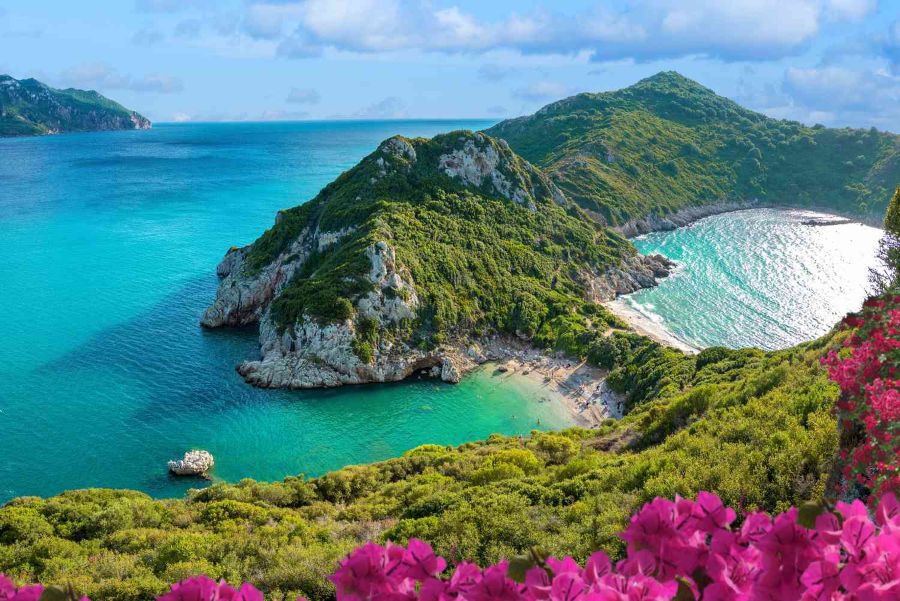
Corfu stands out as one of the greenest islands in Greece. Over 3 million olive trees blanket its rolling hills, creating a silver-green carpet visible from nearly every viewpoint. Ancient cypress trees reach toward the sky, while fragrant citrus groves dot the countryside.
The island’s west coast features dramatic limestone cliffs that plunge into the sparkling Ionian Sea. Hidden coves and sea caves carved by waves provide perfect spots for swimming and snorkeling.
Small rivers and streams crisscross the island’s interior, feeding lush valleys filled with wildflowers in spring. The highest point, Mount Pantokrator, offers sweeping views across the entire island and even glimpses of Albania on clear days.
Lefkada’s Rugged Mountains
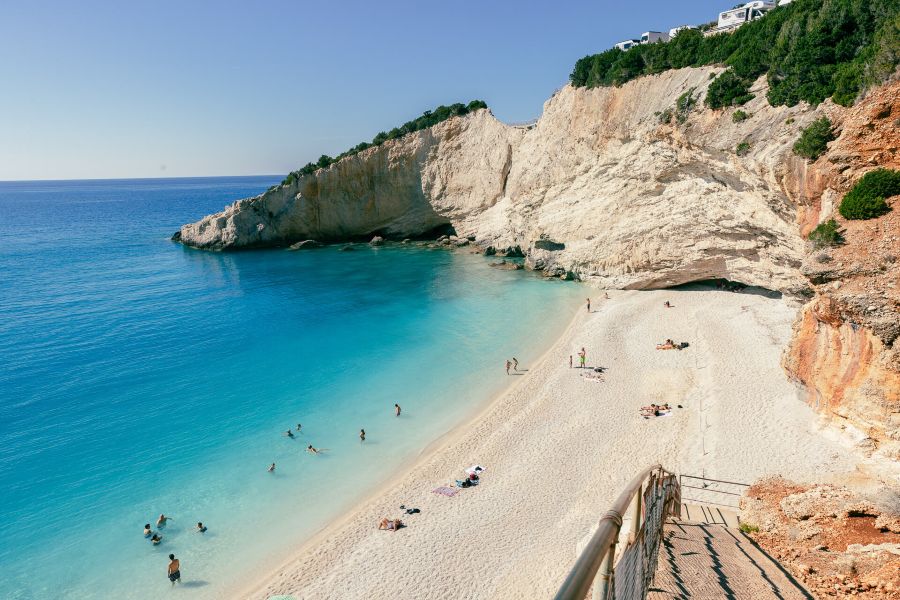
Lefkada’s landscape tells a different story with its stark mountain ranges and steep coastal cliffs. The island’s western shoreline features some of Greece’s most famous beaches, including Porto Katsiki and Egremni, nestled beneath towering white cliffs.
The rugged interior rises dramatically from the coast. Pine forests cover the mountainsides, creating excellent hiking trails with breathtaking sea views. Deep gorges cut through the landscape, revealing hidden waterfalls like the famous Nydri falls.
The mountains provide natural barriers between villages, helping preserve their traditional character. Remote beaches require some effort to reach but reward visitors with pristine sand and crystal-clear waters.
Beaches and Coastal Exploration
The crystal-clear Ionian waters lap against stunning coastlines on both islands, with each offering unique beach experiences. Visitors find pristine sandy stretches and hidden coves perfect for swimming and snorkeling.
Beach Highlights in Corfu
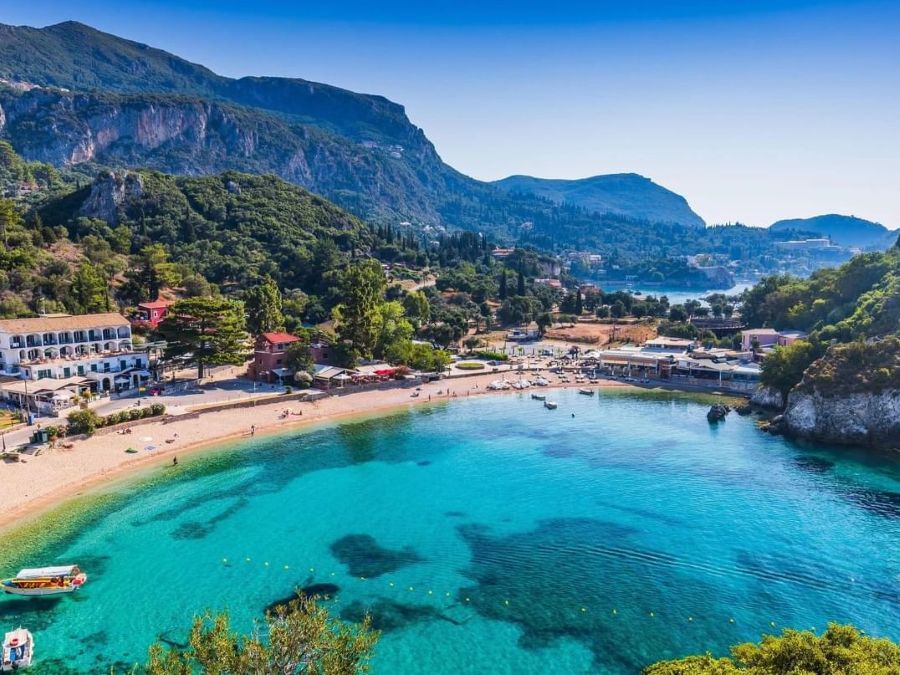
Paleokastritsa stands out as Corfu’s crown jewel, with six stunning blue bays surrounded by olive-covered cliffs. The clear waters make it perfect for snorkeling around the rocky outcrops.
Canal d’Amour beach offers a unique experience with its sandstone formations creating natural tunnels and caves. Local legend says couples who swim through together will get married.
Glyfada Beach draws families with its wide golden sand and gentle waves. Beach bars and water sports rentals line the shore, making it easy to spend a full day here.
Lefkada’s Renowned Beaches
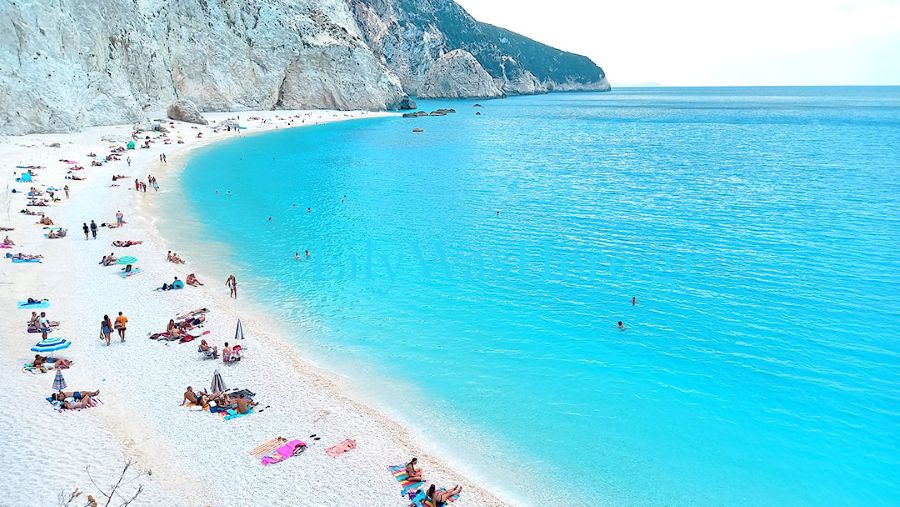
Porto Katsiki is Lefkada’s most famous beach, with dramatic white cliffs dropping down to turquoise waters. The beach’s fine white pebbles create stunning water colors. Access requires descending 347 steps, but the views make it worthwhile.
Egremni Beach stretches for 2.5 km, with white sand and pebbles against crystal waters. The beach feels secluded despite its size, thanks to the steep cliffs behind it.
Kathisma Beach offers excellent swimming conditions and modern facilities. The long stretch of sand provides plenty of space, even during peak season. Water sports enthusiasts can try parasailing or windsurfing here.
Culinary Experiences
The Ionian islands offer distinct flavors that showcase Greece’s rich culinary heritage. Each island brings its own special dishes and cooking traditions to the table.
Local Gastronomy of Corfu
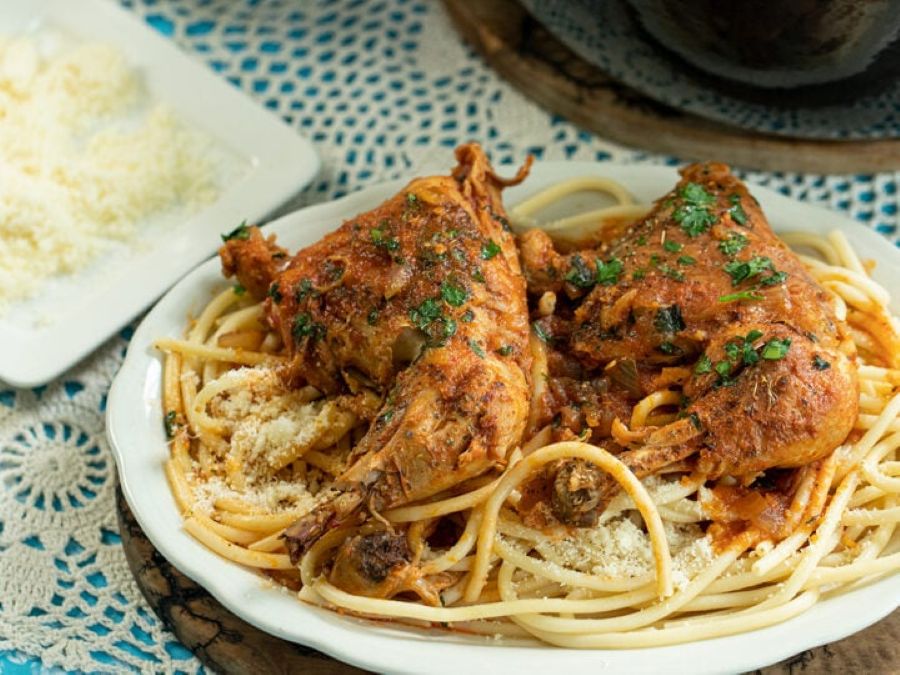
The star of Corfu’s food scene is kumquat – a tiny citrus fruit used in sweets, jams, and liqueurs. You’ll find these bright orange treats in local shops and markets across the island.
Pastitsada, a spicy beef or rooster stew with pasta, stands out as Corfu’s signature dish. The recipe dates back generations and uses a special blend of spices.
Sofrito is another must-try dish – tender veal cooked in wine sauce with garlic and herbs. Pair it with tsitsimbira, Corfu’s own ginger beer, for an authentic local meal.
Lefkada’s Tavernas and Restaurants
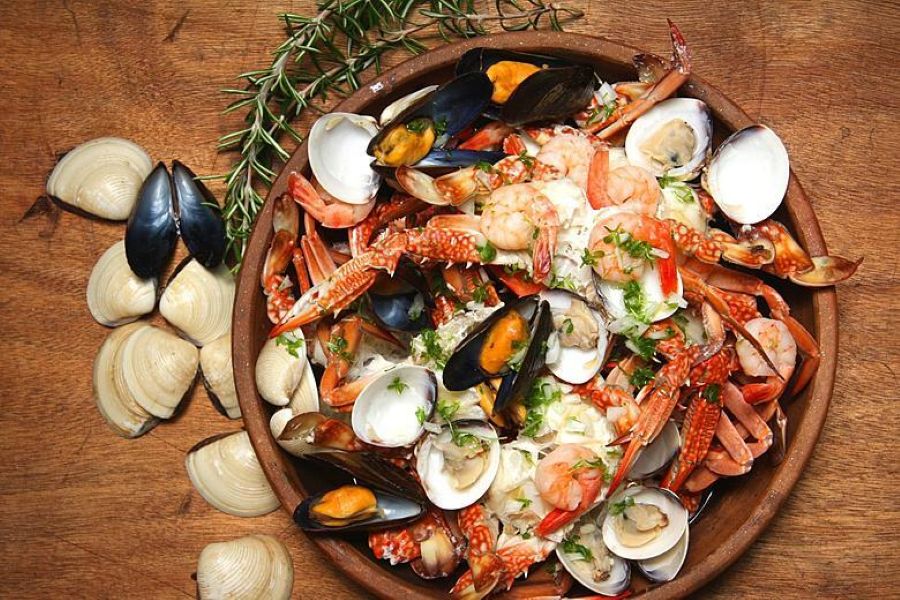
Fresh seafood rules Lefkada’s menus. The island’s tavernas serve up just-caught fish grilled with local olive oil and lemon.
The village of Eglouvi produces special lentils that locals consider the best in Greece. These small, flavorful lentils appear in traditional soups and salads across the island.
Family-run tavernas in Lefkada’s mountain villages offer hearty meat dishes like slow-cooked goat and lamb. Many serve their own house wine made from local grapes.
Village Charm and Culture
Both islands offer enchanting villages filled with authentic Greek character and time-honored traditions. These settlements showcase distinct architectural styles, local customs, and warm hospitality that give visitors a genuine taste of Greek island life.
Picturesque Villages in Corfu
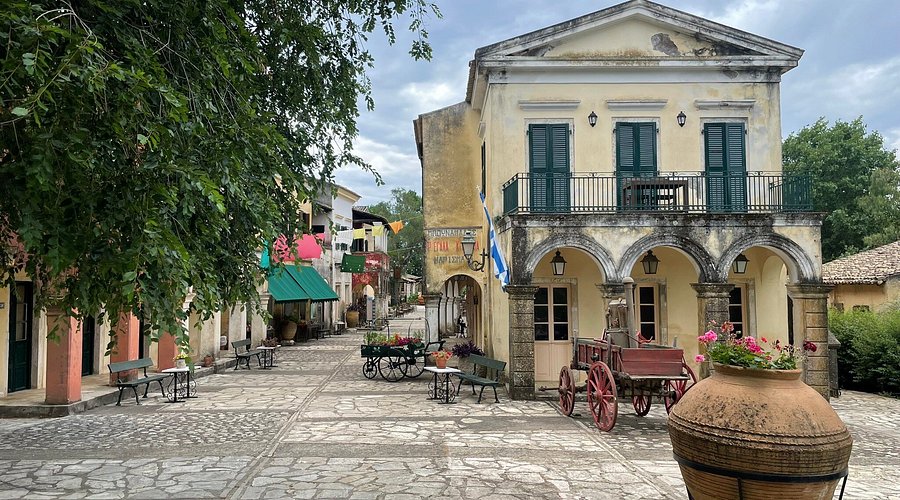
The villages of Corfu blend Venetian influences with traditional Greek charm. Stone houses with red-tiled roofs dot the hillsides, creating postcard-worthy scenes around every corner.
Paleokastritsa stands out with its monastery perched high above the sea. The village’s narrow lanes wind past bright flower gardens and lead to small squares where locals gather at tavernas.
In Kassiopi, a historic fishing village, stone buildings cluster around a Byzantine fortress. Local fishermen still bring their daily catch to the harbor, while craft shops sell handmade items.
Exploring Lefkada’s Villages
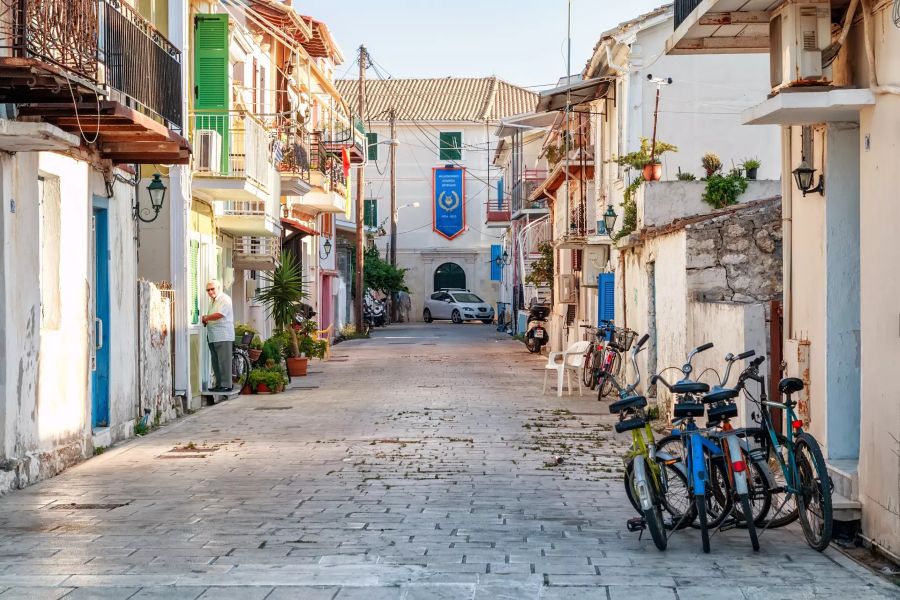
Lefkada’s mountain villages preserve age-old Greek traditions. The village of Karya sits in the island’s heart, famous for its traditional weaving workshops where artisans create intricate textiles.
Agios Nikitas remains one of the most charming coastal villages, with white-washed houses cascading down to a small pebble beach. Its single main street is lined with family-run tavernas serving local specialties.
The hilltop village of Exanthia offers stunning sunset views across the Ionian Sea. Old stone houses and quiet cafes create a peaceful atmosphere where time seems to stand still.
Activities and Experiences
Both islands offer exciting ways to stay active and have fun. Each destination specializes in different adventures that make the most of their unique landscapes and waters.
Outdoor Adventures on Corfu
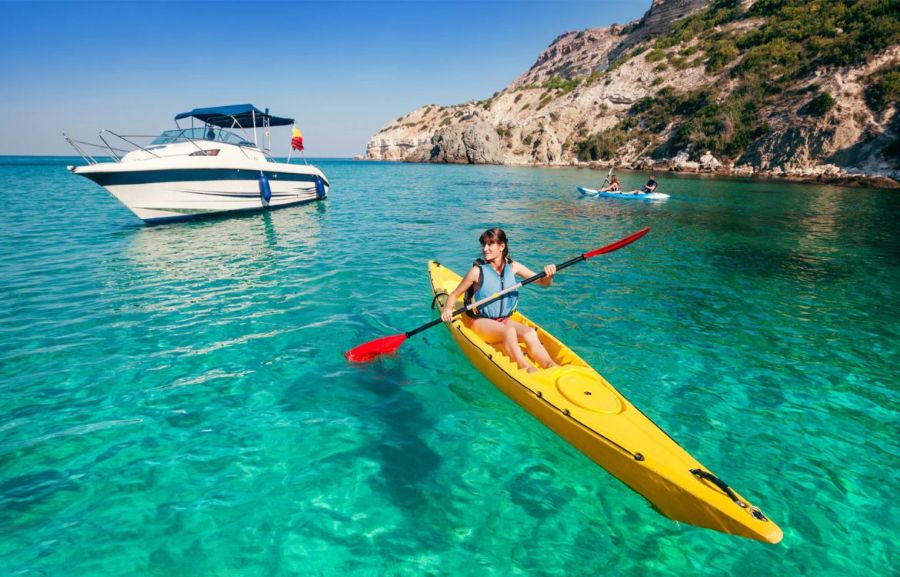
Corfu’s varied terrain creates perfect conditions for exciting outdoor activities. The island features well-marked hiking trails through olive groves and along coastal paths with stunning sea views. Mount Pantokrator offers challenging walks and rewards hikers with panoramic views of Albania and Italy on clear days.
The calm waters around Corfu make it great for water sports. Beginner divers can explore underwater caves and meet colorful fish at spots like Paleokastritsa. The sheltered bays are perfect for kayaking and stand-up paddleboarding.
Mountain biking trails wind through the green interior. Riders can pedal past traditional villages and ancient monasteries on guided cycling tours.
Lefkada’s Adventure Sports
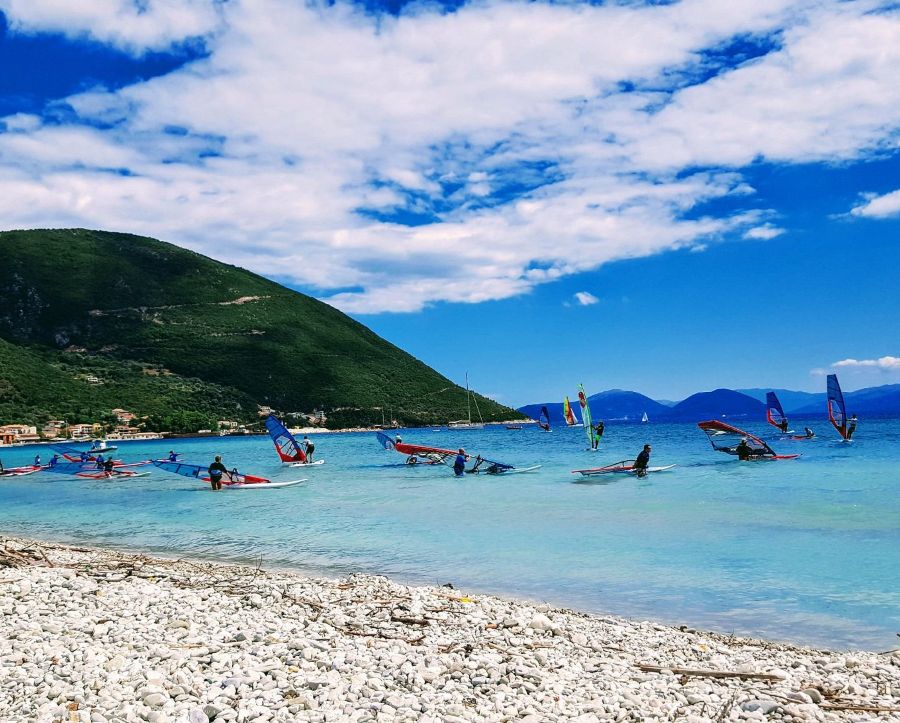
Lefkada is famous for its world-class windsurfing and kitesurfing conditions. The strong afternoon winds at Vasiliki Beach attract water sports enthusiasts from around the globe.
The rugged west coast offers thrilling boat trips to explore hidden caves and remote beaches. Many visitors take sailing lessons or rent small boats to discover secluded coves.
Experienced divers love exploring the underwater cliffs and reefs teeming with sea life. Popular dive sites include the Cave of Papanikolis and the Blue Cave.
The mountain village of Exanthia provides a starting point for scenic hikes through pine forests. Rock climbing opportunities exist on the limestone cliffs above Porto Katsiki beach.
Best Time to Visit
Both islands experience warm Mediterranean summers and mild winters, with distinct peak seasons that affect crowds and prices. Weather patterns shape the best times to plan your Greek island getaway.
Corfu’s Seasonal Attractions

Summer brings perfect beach weather to Corfu from June through September. Temperatures hover around 85°F (29°C) during the day, with little rainfall to spoil outdoor plans.
July and August see the biggest crowds and highest prices. The beaches get packed, and hotel rates jump up quite a bit.
Spring and fall offer milder temps around 70-75°F (21-24°C). You’ll find fewer tourists and better deals on accommodations during these shoulder seasons.
Lefkada’s Peak and Off-Peak Seasons
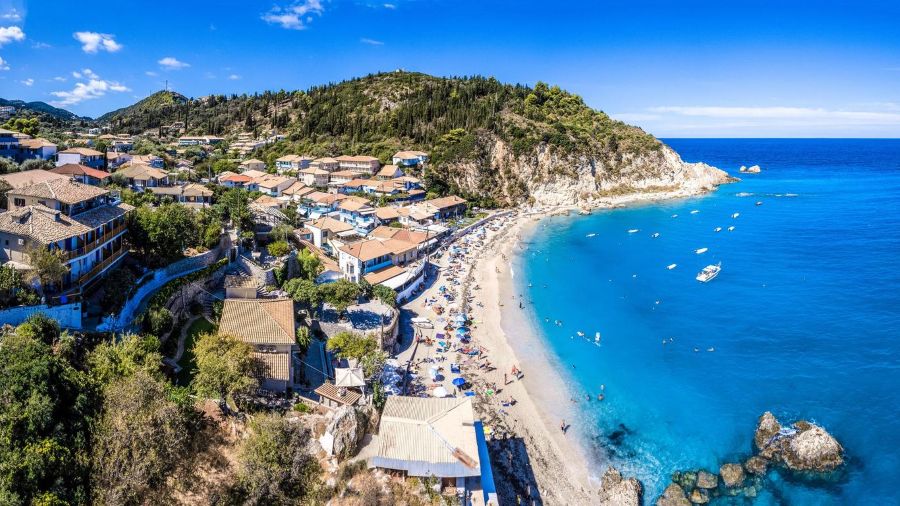
Lefkada’s prime tourist season runs from mid-June to early September. The weather stays sunny and hot, perfect for exploring the famous beaches.
In July, strong winds pick up, making it a top spot for windsurfing and kiteboarding. The breeze helps cool things down during the summer heat.
May and September bring pleasant temperatures without the summer crowds. Hotel prices drop by 30-40% compared to peak season.
Swimming stays comfortable through October, with water temps around 72°F (22°C). Some restaurants and shops start closing for winter by late October.
Frequently Asked Questions
These two Ionian islands pack distinct experiences, from sandy beaches to ancient ruins, each with their own special charm. Travelers often want to know the key differences to pick the perfect spot for their Greek vacation.
What are the main differences in attractions between Corfu and Lefkada?
Corfu shines with its UNESCO World Heritage Old Town, filled with Venetian architecture and winding cobblestone streets. The island’s main draw includes the famous Achilleion Palace and Mon Repos Estate.
On the other hand, Lefkada focuses more on natural attractions like the Porto Katsiki beach and the Cape Lefkada lighthouse. The island’s waterfalls and hiking trails attract outdoor enthusiasts.
Can you recommend which island is better for families, Corfu or Lefkada?
If you want more organized activities, book your family vacation in Corfu. The island offers water parks, kid-friendly resorts, and easy-to-reach beaches.
On the other hand, Lefkada works well for families who prefer a quieter pace. Its connection to mainland Greece makes travel easier, and the calm waters of many beaches suit young swimmers.
What distinguishes Corfu’s nightlife compared to that of Lefkada?
Corfu buzzes with energy after dark, especially in areas like Kavos and Corfu Town. The island hosts numerous bars, clubs, and beach parties throughout summer.
In contrast, Lefkada offers a more laid-back evening scene. Small tavernas and beachfront bars provide entertainment without the big crowds.
How do the beaches of Lefkada measure up against those in Corfu?
Lefkada’s beaches stand out for their dramatic white cliffs and crystal-clear waters. Porto Katsiki and Egremni rank among Greece’s most photographed spots.
Meanwhile, Corfu features a mix of sandy and pebbly beaches. Popular spots like Paleokastritsa offer great swimming and snorkeling opportunities.
Which island offers more cultural and historical experiences, Corfu or Lefkada?
Corfu wins for history buffs with its rich cultural heritage. The island showcases French, British, and Venetian influences in its architecture and customs.
On the other hand, Lefkada’s history feels more traditionally Greek. Ancient ruins and medieval churches dot the landscape, telling stories of its past.
In terms of natural scenery, do Corfu or Lefkada offer more unique landscapes?
Lefkada impresses with its rugged west coast cliffs and turquoise waters. The island’s interior features olive groves and cypress forests.
Corfu blends lush green mountains with coastal scenery. The island earned its nickname “Emerald Isle” from its abundant olive trees and cypress forests.
